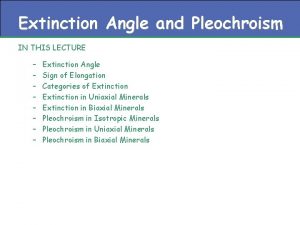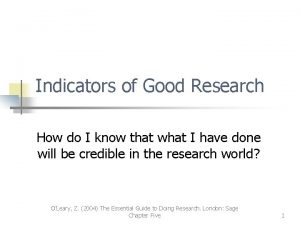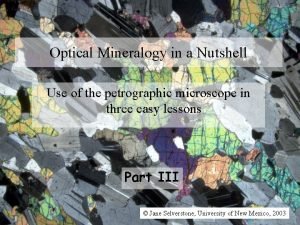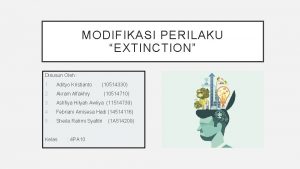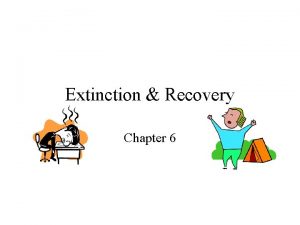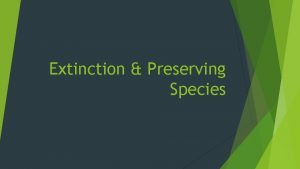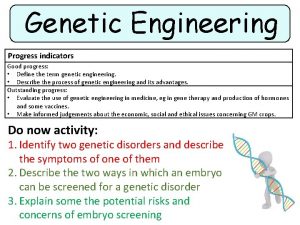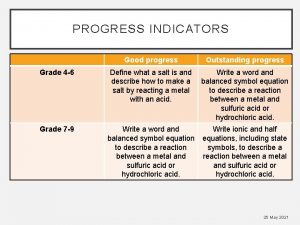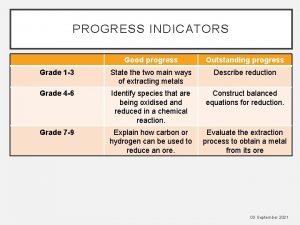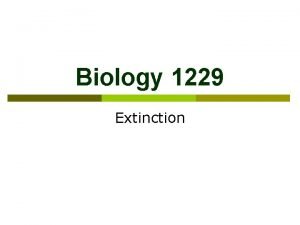Extinction Progress indicators Good progress Define the term











- Slides: 11

Extinction Progress indicators Good progress: • Define the term extinction • Explain how extinction may be caused. Outstanding progress: • Explain that organisms become extinct because something changes and the species cannot adapt quickly enough to the new circumstances. Do now activity: 1. How do fossils provide us with evidence of evolution? 2. Why can the fossil record be described as an ‘incomplete’ record? 3. What factors can cause a species to be endangered? And eventually go extinct?

What does extinction mean? Task: Watch the video and answer the following questions: 1. Why did people struggle with the concept of extinction? 2. 3. Because many people still believed that God created all living creatures on Earth and wouldn’t allow them to die out. Plus nobody believed the Earth was very old. What did George Cuvier believe caused the extinction of Mammoths and other organisms? Catastrophic events Which organisms have become extinct because of human action? Tasmanian wolf, Dodo, Stella sea cow EXTRA CHALLENGE: Can you define ‘extinction'? Extinction: The permanent disappearance of a species, either globally or locally. http: //www. bbc. co. uk/programmes/p 011 fmxj

There are many causes of extinction, but all involve a change in the environment of an organism. How many did you get? New predator More successful competitor THINK > PAIR > SHARE: Can you come up with any examples of changes occurring within an organisms environment which may put them at risk of extinction? New diseases Volcanic eruptions Asteroid collision Change in temperature

Causes of Extinction Task: In groups you have been given a set of information cards on causes of extinction. For each one write a couple of summary sentences to explain how this factor can lead to extinction of a species. 1. 2. 3. 4. 5. Habitat destruction Introduced species Hunting and fishing Environmental change New diseases

Examples of extinction In groups you will be given cards of information on different organisms and the reasons why they are being pushed to extinction Task: Complete the following table to include the 5 different organisms which are now extinct: Species Habitat Reason(s) Extra information for why it is endangered/ extinct

Mass extinctions Fossil evidence shows that at times there have been mass extinctions on a global scale. During these events many (or sometimes even most) or the species on Earth died out. Task: Watch the video and answer the following questions: https: //www. youtube. com/watch? v=RAd. NCIIYXvo 1. Name two examples of catastrophic events which could lead to a mass extinction 2. Describe the impact of these two events on the survival of organisms at that time 3. Define ‘mass extinction’ 4. How do extinction rates today compare to the ‘normal’ background rate of extinction? Explain your answer.

Self-assessment: 1. Asteroid colliding with Earth, volcanic eruptions causing ash clouds to envelop the Earth’s atmosphere. 2. Volcanic eruptions would have caused carbon dioxide to fill the atmosphere and the asteroid would have colliding with the ground causing dust to fill the air. This dust would have stopped photosynthesis for many plants, causing them to die out. The herbivores which fed on these plants would have therefore died out, along with the carnivores which preyed on them. 3. Mass extinction is when thousands of species are killed off in one geological period of time 4. Extinction rates today are hundred to thousands times higher than the normal background extinction rates. This is due to human interactions with the environment, driving extinction rates faster than they should be.

Plenary ~ Twitter message Task: Pretend you are a conservationist working for a charity that is trying to stop the extinction of one of the organisms you studied earlier in the lesson. Write a twitter message to your followers to raise awareness of the issues that are critically affecting this organism. #keywords

The Western Gorilla was changed from Endangered to Critically Endangered in 2007 after the Western Lowland Gorilla (G. g. gorilla) subspecies, suffered a population decline of more than 60% since the early 1980 s. Hunting and deaths caused by Ebola were the main causes of this decline and both these threats continue to affect the Western Lowland Gorilla population. Sumatran Orangutan) is listed as Critically Endangered. Endemic to the island of Sumatra in Indonesia, this ape has suffered a population decline of more than 80% over the last 75 years. The species is seriously threatened by logging (both legal and illegal), wholesale conversion of forest to agricultural land, and oil palm plantations, and fragmentation by roads. Cyanea superba is listed as Extinct in the Wild. This tree was endemic to the island of O'ahu in the Hawaiian Islands. More than 60 plants in two subpopulations were known in the 1970 s, the species then declined to only five plants and these too have finally gone. The causes of the wild population’s extinction were competition with alien plants, habitat degradation by feral pigs, slugs and wildfire. Maui Hesperomannia , listed as Critically Endangered, is a small shrubby tree known only from the Hawaiian Islands of Maui and Oahu. There has been an observed population decline of 25 -50% over the last three years and the number of known individuals is less than 25. Main threat is because of competition with alien plant species (prickly Florida blackberry, Christmas berry, Koster's curse and strawberry guava)

Channel Islands Fox is a Critically Endangered canid restricted to six of the California Channel Islands off the coast of southern California, USA. The population has suffered declines of more than 80% in recent years, primarily caused by golden eagle predation and possibly also introduction of canine disease such as canine distemper virus (CDV). Population decline is expected to continue. The Polar Bear (Ursus maritimus) is classed as Vulnerable. Recent modelling of the trends for sea ice extent, thickness and timing of coverage predicts dramatic reductions in sea ice coverage over the next 50 to 100 years due to global climate change. It is suspected that there will be a population reduction of at least 30% over the next 45 years as a result of this habitat loss and declining habitat quality. Telestes polylepis is a Critically Endangered freshwater fish, known only from a very small stream (1 m wide and 2 km long) in Stanicka Jaruga, Croatia. Ongoing habitat degradation caused by water extraction and the presence of introduced trout species threatens the survival of this fish Atelopus varius is a Critically Endangered harlequin toad that was once abundant in Costa Rica and western Panama. Declines began at Monteverde in 1988, and by 1996 it was believed to be extinct in Costa Rica. The cause of its decline is possibly a result of the fungal disease, chytridiomycosis.

Climate Change CO 2 is produced naturally for example through respiration and also through human activity, e. g. burning fossil fuels. CO 2 causes the greenhouse effect, and therefore global warming. The higher levels of CO 2 can lead to acidification of sea water due to excess carbon dioxide dissolving in the sea, this effects many aquatic organisms. In Artic and Antarctic regions this warming effect is particular dangerous, the reduction in sea ice means that many species that are adapted to life on top or under ice are at risk of extinction. Organisms that do well in the temperature of a tropical climate wouldn’t do well in the freezing conditions of an Ice Age. Many of them would become extinct through lack of food or being too cold to breed. New diseases can bring a species to the point of extinction. They are most likely to cause extinction on islands where the whole population of a an animal or plant is closer together. A modern day example is the Australian Tasmanian devil, these rare animals are dying from a new form of communicable cancer which attacks and kills them very quickly. Hunting and Fishing Human population increase has lead to a higher demand of food. Increase in hunting/fishing rates Some animals are also hunted for their fur or ivory. Habitat Destruction Humans are destroying natural habitats for the benefits of resources, urbanization and agriculture. • Deforestation – Amazon rainforest • Destruction of coral reefs – side effect of trawler fishing Introduced species Species that are introduced to a habitat accidentally or purposefully. Accidental: • hitchhiking Intentional: • Pets or food crops Competition A new species may cause natives to have to compete for resources (food, shelter). Predation New species may predate upon the native species. (For example the Stephen’s Island Wren). If the prey animals do not have the adaptations to avoid the new predators they will very quickly be wiped out. Disease The new species may bring a disease to the native habitat, a disease to which they are immune to, but the native species are very vulnerable to. (For example the Grey Squirrel)
 Background extinction vs mass extinction
Background extinction vs mass extinction Extinction angle
Extinction angle Physical progress and financial progress
Physical progress and financial progress Zoroastrianism good thoughts good deeds
Zoroastrianism good thoughts good deeds Hi, good afternoon
Hi, good afternoon Good afternoon animado
Good afternoon animado If you are
If you are Hello teacher good afternoon
Hello teacher good afternoon Indicators of good research
Indicators of good research Optical activity
Optical activity Simultaneous extinction
Simultaneous extinction Extinction burst adalah
Extinction burst adalah

